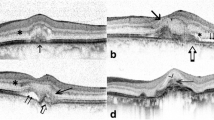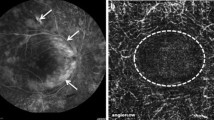Abstract
Purpose
Compared with fluorescein angiography (FA), the gold standard for diagnosing choroidal neovascularization (CNV) activity, optical coherence tomography angiography (OCTA) is non-invasive without risks associated with fluorescein dye use, and may be especially advantageous in the diagnosis and monitoring of children with CNV.
Methods
Eight eyes from eight patients aged 12 months to 18 years were imaged with the investigational Spectralis OCTA (version 6.9, Heidelberg Engineering, Heidelberg, Germany) and the RTVue XR Avanti (Optovue Inc., Fremont, CA, USA). Two patients were imaged during examination under anesthesia while six patients were imaged in the clinic. Demographic information, ocular characteristics, treatment history, and imaging studies (color photos, fluorescein angiography, OCT) were collected and reviewed.
Results
Three eyes had active CNV while five had quiescent CNV at the time of imaging. CNV was idiopathic or secondary to trauma, retinal vascular dysgenesis versus retinopathy of prematurity, pigmentary retinopathy, Best vitelliform macular dystrophy, panuveitis, morning glory disc anomaly, and optic disc drusen. OCTA of two active CNV demonstrated presence of a main trunk with multiple fine capillaries, vessel loops, and anastomoses. OCTA was repeated after treatment for two CNV and demonstrated a decrease in size with loss of fine capillaries, vessel loops, and anastomoses. For the third active CNV, OCTA verified flow in the CNV complex despite the uncertainty of FA hyperfluorescence in the setting of grossly abnormal retinal vasculature. The five quiescent CNV all lacked fine capillaries, vessel loops, and anastomoses on OCTA.
Conclusion
OCTA demonstrates morphological differences between active and quiescent pediatric CNV.




Similar content being viewed by others
References
Spaide RF (1999) Choroidal neovascularization in younger patients. Curr Opin Ophthalmol 10(3):177–181
Grewal DS, Tran-Viet D, Vajzovic L, Mruthyunjaya P, Toth CA (2017) Association of pediatric choroidal neovascular membranes at the temporal edge of optic nerve and retinochoroidal coloboma. Am J Ophthalmol 174:104–112. https://doi.org/10.1016/j.ajo.2016.10.010
Sears J, Capone A Jr, Aaberg T Sr, Lewis H, Grossniklaus H, Sternberg P Jr, DeJuan E (1999) Surgical management of subfoveal neovascularization in children. Ophthalmology 106(5):920–924. https://doi.org/10.1016/S0161-6420(99)00510-2
Fung TH, Muqit MM, Mordant DJ, Smith LM, Patel CK (2014) Noncontact high-resolution ultra-wide-field oral fluorescein angiography in premature infants with retinopathy of prematurity. JAMA Ophthalmol 132(1):108–110. https://doi.org/10.1001/jamaophthalmol.2013.6102
Hara T, Inami M, Hara T (1998) Efficacy and safety of fluorescein angiography with orally administered sodium fluorescein. Am J Ophthalmol 126(4):560–564
House RJ, Hsu ST, Thomas AS, Finn AP, Toth CA, Materin MA, Vajzovic L (2019) Vascular findings in a small retinoblastoma tumor using OCT angiography. Ophthal Retina 3(2):194–195
Hsu ST, Chen X, House RJ, Kelly MP, Toth CA, Vajzovic L (2018) Visualizing macular microvasculature anomalies in 2 infants with treated retinopathy of prematurity. JAMA Ophthalmol 136(12):1422–1424
Hsu ST, Chen X, Ngo HT, House RJ, Kelly MP, Enyedi LB, Materin MA, El-Dairi MA, Freedman SF, Toth CA, Vajzovic L (2018) Imaging infant retinal vasculature with OCT angiography. Ophthalmology Retina 3(1):95–96
Hsu ST, Finn AP, Chen X, Ngo HT, House RJ, Toth CA, Vajzovic L (2019) Macular microvascular findings in familial exudative vitreoretinopathy on optical coherence tomography angiography. Ophthalmic Surg Lasers Imaging Retina 50(5):322–329. https://doi.org/10.3928/23258160-20190503-11
Veronese C, Maiolo C, Huang D, Jia Y, Armstrong GW, Morara M, Ciardella AP (2016) Optical coherence tomography angiography in pediatric choroidal neovascularization. Am J Ophthalmol Case Rep 2:37–40. https://doi.org/10.1016/j.ajoc.2016.03.009
Qian CX, Charran D, Strong CR, Steffens TJ, Jayasundera T, Heckenlively JR (2017) Optical coherence tomography examination of the retinal pigment epithelium in best vitelliform macular dystrophy. Ophthalmology 124(4):456–463. https://doi.org/10.1016/j.ophtha.2016.11.022
Coscas GJ, Lupidi M, Coscas F, Cagini C, Souied EH (2015) Optical coherence tomography angiography versus traditional multimodal imaging in assessing the activity of exudative age-related macular degeneration: a new diagnostic challenge. Retina 35(11):2219–2228. https://doi.org/10.1097/IAE.0000000000000766
Liang MC, de Carlo TE, Baumal CR, Reichel E, Waheed NK, Duker JS, Witkin AJ (2016) Correlation of spectral domain optical coherence tomography angiography and clinical activity in neovascular age-related macular degeneration. Retina 36(12):2265–2273. https://doi.org/10.1097/IAE.0000000000001102
Huang D, Jia Y, Rispoli M, Tan O, Lumbroso B (2015) OCT Angiography of time course of choroidal neovascularization in. Retina 35(11):2260–2264
de Carlo TE, Bonini Filho MA, Chin AT, Adhi M, Ferrara D, Baumal CR, Witkin AJ, Reichel E, Duker JS, Waheed NK (2015) Spectral-domain optical coherence tomography angiography of choroidal neovascularization. Ophthalmology 122(6):1228–1238. https://doi.org/10.1016/j.ophtha.2015.01.029
Moult E, Choi W, Waheed NK, Adhi M, Lee B, Lu CD, Jayaraman V, Potsaid B, Rosenfeld PJ, Duker JS, Fujimoto JG (2014) Ultrahigh-speed swept-source OCT angiography in exudative AMD. Ophthalmic Surg Lasers Imaging Retina 45(6):496–505. https://doi.org/10.3928/23258160-20141118-03
Coscas GJ, Lupidi M, Coscas F (2014) Optical coherence tomography angiography versus traditional multimodal imaging in assessing the activity of exudative age-related macular degeneration. Retina 35(11):2219–2228
Gong J, Yu S, Gong Y, Wang F, Sun X (2016) The diagnostic accuracy of optical coherence tomography angiography for neovascular age-related macular degeneration: a comparison with fundus fluorescein angiography. J Ophthalmol 2016:7521478. https://doi.org/10.1155/2016/7521478
Inoue M, Jung JJ, Balaratnasingham C, Dansingani KK, Dhrami-Gavazi E, Suzuki M (2016) A comparison between optical coherence tomography angiography and fluorescein angiography for the imaging of type 1 neovascularization. Invest Ophthalmol Vis Sci 57(9):OCT314–OCT323
Carnevali A, Cicinelli MV, Capuano V, Corvi F, Mazzaferro A, Querques L, Scorcia V, Souied EH, Bandello F, Querques G (2016) Optical coherence tomography angiography: a useful tool for diagnosis of treatment-naive quiescent choroidal neovascularization. Am J Ophthalmol 169:189–198. https://doi.org/10.1016/j.ajo.2016.06.042
Faridi A, Jia Y, Gao SS, Huang D, Bhavsar KV, Wilson DJ, Sill A, Flaxel CJ, Hwang TS, Lauer AK, Bailey ST (2017) Sensitivity and specificity of OCT angiography to detect choroidal neovascularization. Ophthalmol Retina 1(4):294–303. https://doi.org/10.1016/j.oret.2017.02.007
Camino A, Zhang M, Gao SS, Hwang TS, Sharma U, Wilson DJ, Huang D, Jia Y (2016) Evaluation of artifact reduction in optical coherence tomography angiography with real-time tracking and motion correction technology. Biomed Opt Express 7(10):3905–3915. https://doi.org/10.1364/BOE.7.003905
de Carlo TE, Romano A, Waheed NK, Duker JS (2015) A review of optical coherence tomography angiography (OCTA). Int J Retina Vitreous 1:5. https://doi.org/10.1186/s40942-015-0005-8
Funding
This study was funded by the International Association of Government Officials (iGO) Fund, Knights Templar Eye Foundation, Research to Prevent Blindness Unrestricted Grant to Duke Eye Center, NIH RO1 EY25009, NIH P30 EY005722 (Duke Eye Center Core Grant), Research equipment (Spectralis tabletop and Flex module), and grant provided by Heidelberg Engineering.
Author information
Authors and Affiliations
Corresponding author
Ethics declarations
Conflict of interest
DG has received research grants from Alimera Sciences and Allergan. JFA holds a patent from Springer SBM LLC; is a consultant for Turing Pharmaceuticals LLC, DORC International B.V., Allergan Inc., Bayer, and Mallinckrodt; and has received research grants from TOPCON. MAE has received research grants from the Knights Templar Eye Foundation. CAT receives royalties from Alcon and has received a research grant from NIH (RO1 EY25009). LV receives research grants from Janssen Pharmaceutical, Roche, DORC, Second Sight, Alcon, Genentech, B&L, and Alimera Sciences. STH declares that she has no conflict of interest. SSO declares that she has no conflict of interest.
Ethical approval
All procedures performed in studies involving human participants were in accordance with the ethical standards of the Duke University and Johns Hopkins University and with the 1964 Helsinki declaration and its later amendments or comparable ethical standards. This article does not contain any studies with animals performed by any of the authors.
Informed consent
Informed consent was obtained from all individual participants included in the study from Duke University. One participant was retrospectively included from Johns Hopkins University and no consent was obtained from this single case report.
Disclaimer
Its contents are solely the responsibility of the authors and do not necessarily represent the official view of NIH. The sponsors or funding organizations had no role in the design or conduct of this research.
Additional information
Publisher’s note
Springer Nature remains neutral with regard to jurisdictional claims in published maps and institutional affiliations.
Rights and permissions
About this article
Cite this article
Ong, S.S., Hsu, S.T., Grewal, D. et al. Appearance of pediatric choroidal neovascular membranes on optical coherence tomography angiography. Graefes Arch Clin Exp Ophthalmol 258, 89–98 (2020). https://doi.org/10.1007/s00417-019-04535-4
Received:
Revised:
Accepted:
Published:
Issue Date:
DOI: https://doi.org/10.1007/s00417-019-04535-4




